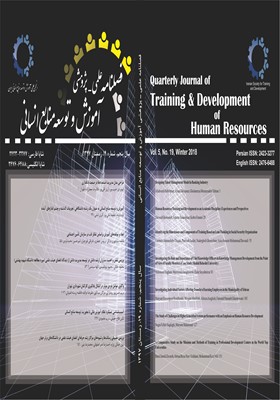Designing an Empowerment pattern for Sepah bank staff Based on Organizational Learning
Subject Areas :Marzieh Damirchi 1 , Rasul Hoseini 2 , Masumeh Oladian 3
1 -
2 -
3 -
Keywords: Empowering employees, organizational learning, learned organization, Empowerment Pattern, Sepah bank.,
Abstract :
Competition in today's world is not having assets but having two other essential elements. One is investing in knowledge and learning in the organization, and the other one is the training of capable employees. The purpose of this study was to design a staff empowerment model based on organizational learning. The research method has been used in terms of qualitative-quantitative nature (mixed) in terms of applied type and in mixed research methods, exploratory method is used sequentially. The data collection tool was semi-structured in the qualitative section of the interview and a researcher made questionnaire in the quantitative section. The statistical community in the qualitative sector is the knowledge and expertise of human resources in the banking system and universities. Sampling was done using a non-probabilistic sampling method including targeted techniques (snowball chains), based on which 18 interviews with experts in the banking industry took place and from among them, it was interviewed with 10 people through the focal group. For analysis of qualitative information, content analysis and open, axial and selective coding method is used and in this way, the MAXQDA2018 software is used. The statistical populations in the quantitative chiefs of staff and managers of Sepah bank branches in Tehran province were 322 people. A sample of 175 people was identified using the Cochran formula & stratified sampling. For analyzing quantitative data, structural equation and PLC software have been used. The obtained pattern includes organizational learning relationships and empowerment of employees, components, indicators and impacts of empowerment based on organizational learning. Based on research findings, empowerment of employees based on organizational learning leads to productivity, dynamism and agility.
1. Amit S, Shailendra S, Himanshu R. Abhijit Bhattacharya Employee Empowerment Leading to Flexible Role Orientation: A Disposition Based Contingency Framework. IIMB Management Review. 2018; 21(2): 12-25.
2. Saadat E. Human resources management. 2011. Tehran: Samt Publishers.
3. Divesh O, et al. Supply chain organizational learning, exploration, exploitation, and firm performance: A creation-dispersion perspective. International Journal of Production Economics. 2018; 204(1): 70-82.
4. Khurshid A. Part of the series The World Council of Comparative Education Societies. Globalized Local & Localized Global in a Women’s Education. 2016; 6(2):23-39.
5. Allahyari R, et al. Survey of relationship between the psychological empowerment of employees with organizational learning. Procedia - social and behavioral sciences. 2011; 30(1): 1549-54.
6. Acacia N. Vocational Training & Agency Among Kenyan Youth. 2016; 11(1): 57-63.
7. Orr B. Organizational learning: characteristics of learning organizations. Canadian H R Reporter. 2000; 13 (10):34-53.
8. Senj P. The fifth command. Translated by Hafez Kamalehedayat &Mohammad Roshan. 2007. Tehran: Publishers Industrial Management Institute.
9. Huber G.P. Organizational Learnin: The Contributing Process & the Literature. Organization Science. 1991; 37(1): 87-98.
10. Rahnavard F. Learning organization & learned organization. 1999; 7(2): 23-31.
11. Skerlavaj M, Stemberger M.I, Skrinjar R, Dimovski V. Organization learning culture- the missing link between business process chang & organizational performance. Int. j. production Economics. 2007; 106(1): 57-71.
12. Hosnavi R, Ramezan M. Increased intellectual capital in the organization. Investigating the role of organizational learning. Management Improvement Journal. 2017; 5(1): 25-39.
13. Johnson L. Culturally Responsive Leadership for Community Empowerment. 2016; 9(1): 183-199.
14. Spritzer G.M, Kiziols M.A, Nason S. w. a dimensional Analysis of the Relationship between Psychological Empowerment & Effectiveness, Satisfaction & Strain. Journal of Management. 2007; 23(1): 43-56.
15. Scott B, Christian D. Ethical leadership and employee success: Examining the roles of psychological empowerment and emotional exhaustion. The Leadership Quarterly L.Greenbaum. 2018; 7(2): 97-108.
16. Ardharn K, Vinai P. Structural equation model to assess the impact of learning organization and commitment on the performance of research organizations Kasetsart. Journal of Social Sciences. 2018; 39(1): 457-462.
17. Robinz E. Organization Theory Structure, design and applications. Ttranslated by Seyed Mahdi Alvani & Hasan Danaeefard. 2002. Tehran: Safar.
18. Conge J.A, Kanungo R.N. The empowerment process: integrating theory & practice. Academy of Management Review. 1998; 13(1): 67-81.
19. Zimmerman M.A. Taking aim on empowerment research: On the distinction between individual & psychological conception. American Journal of Community Psychology. 1990; 8(2): 19-38.
20. Bennis W, Nanus B. Leaders: The strategies for taking charge. New York: Harper & Row. 1998; 5(1): 116-189.
21. Bazarghan A. Mixed research methods: A superior approach to studying and solving educational problems. Quarterly Schools Efficient. 2008; 6(1): 31-44.


